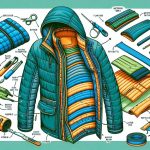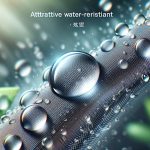Choosing between water-resistant and waterproof fabrics can feel like deciding between a raincoat and a sponge. Understanding the distinctions is essential for staying dry and comfortable during your outdoor adventures. Water-resistant materials may seem sufficient at first glance, but they can leave you vulnerable in heavy rain. So, how do you know which option truly fits your needs? Let’s explore the key differences that can make or break your next outing.
Table of Contents
Key Takeaways
- Water-resistant fabrics provide limited moisture protection, suitable for light rain, while waterproof fabrics completely block water in heavy conditions.
- Fabric construction, such as tight weaves and special coatings, impacts the water resistance and durability of the material.
- Water-resistant fabrics can become saturated over time, whereas waterproof fabrics can still allow sweat to escape while keeping water out.
- Breathability varies, with water-resistant fabrics generally allowing better airflow, but advanced waterproof options can offer a balance between moisture protection and comfort.
- Selecting the right fabric depends on the activity and environmental conditions, with specific needs for breathability, durability, and moisture management.
Definition and Purpose of Water-Resistant and Waterproof Fabrics
When you’re choosing fabrics for outdoor gear or clothing, it’s essential to understand the difference between water-resistant and waterproof materials.
Water-resistant fabrics offer some protection against moisture but can eventually let water seep through under heavy rain or prolonged exposure. They’re great for light showers or misty conditions, making them suitable for everyday wear.
Water-resistant fabrics provide limited moisture protection, ideal for light rain and everyday use, but may not withstand heavy downpours.
On the other hand, waterproof fabrics are designed to keep water out entirely, even in harsh weather. These materials often feature specialized coatings or membranes that block water while allowing moisture from sweat to escape.
Knowing the purpose of each type helps you select the right gear for your activities, ensuring you stay dry and comfortable, no matter the conditions you face outdoors.
Construction Materials and Techniques
When choosing between water-resistant and waterproof fabrics, understanding the construction materials and techniques is essential.
You’ll notice that fabric weave differences play a significant role in water protection, while various coatings and treatments can enhance performance.
Let’s explore how these factors influence the effectiveness of your gear.
Fabric Weave Differences
While you might think all fabrics are created equal, the weave of a material considerably impacts its water resistance and overall durability.
Fabrics with tight weaves, like ripstop nylon, create fewer gaps for water to penetrate, enhancing their water-resistant qualities. Conversely, looser weaves allow for more airflow but can compromise the fabric’s ability to repel water.
Additionally, different weaving techniques, such as plain weave versus twill weave, affect how the fabric responds to moisture.
Plain weaves are often lighter and more breathable, making them suitable for warmer conditions, while twill weaves provide a sturdier structure, offering increased durability.
Understanding these differences can help you choose the right fabric for your specific needs, ensuring you stay comfortable and dry in various conditions.
Coatings and Treatments
To enhance water resistance, many fabrics undergo various coatings and treatments that greatly improve their performance in wet conditions. These processes often involve applying a durable water repellent (DWR) finish, which creates a barrier against moisture.
You might also encounter fabrics treated with polyurethane or silicone, adding an extra layer of protection against water penetration.
Additionally, some manufacturers use lamination techniques to sandwich a waterproof membrane between layers of fabric. This not only keeps water out but also allows breathability, preventing condensation inside.
When choosing water-resistant or waterproof gear, consider the coatings or treatments used, as they can notably impact effectiveness, durability, and overall comfort.
Always check product descriptions to confirm you’re getting the level of protection you need.
Performance in Varied Weather Conditions
When you’re choosing between water-resistant and waterproof fabrics, it’s essential to take into account how they perform in different weather conditions.
Rain protection levels can vary greatly, and humidity can impact comfort and durability.
Plus, understanding wind resistance helps you select the right fabric for your outdoor adventures.
Rain Protection Levels
Although many people assume all fabrics offer the same level of rain protection, the reality is quite different.
When you’re caught in a downpour, you’ll appreciate the distinction between water-resistant and waterproof materials. Water-resistant fabrics can handle light rain, providing some protection but allowing moisture to seep through over time.
On the other hand, waterproof fabrics are engineered to keep you completely dry, even during heavy rainfall.
When choosing your gear, consider the specific weather conditions you’ll face. For light showers, a water-resistant option might suffice.
However, if you’re venturing into areas prone to heavy rain, opt for waterproof fabrics to guarantee you stay comfortable and dry. Your choice directly impacts your experience in unpredictable weather.
Humidity Effects
Weather conditions aren’t just about rain; humidity plays a significant role in how fabrics perform too.
When the humidity rises, water-resistant fabrics can struggle. They’re designed to repel water but can become saturated in high humidity, leading to discomfort and a clammy feel against your skin.
Waterproof fabrics, on the other hand, often provide better protection against moisture in humid conditions, as they block water from entering. However, they can trap sweat, making breathability a concern.
You’ll want to take into account this when choosing your gear for humid climates. Look for fabrics with moisture-wicking properties or ventilation features to enhance comfort while staying dry.
Ultimately, understanding how humidity affects your fabric choice can improve your outdoor experience.
Wind Resistance Comparison
Wind resistance is vital for outdoor gear, especially if you’re facing unpredictable weather. When considering fabrics, it’s important to understand how each type performs against the wind.
Water-resistant fabrics typically offer basic protection against light winds but may not hold up under stronger gusts. In contrast, waterproof fabrics often come with wind-resistant properties, providing a better barrier against harsh conditions.
If you’re planning to hike or engage in other outdoor activities, opt for waterproof gear with wind-resistant features. This combination guarantees you stay dry and comfortable, no matter what Mother Nature throws your way.
Breathability and Comfort Levels
When choosing between water-resistant and waterproof fabrics, it’s essential to take into account breathability and comfort levels. Water-resistant fabrics typically allow for better airflow, making them more comfortable for active use. In contrast, waterproof fabrics can trap moisture and heat, leading to discomfort during extended wear.
Here’s a quick comparison to help you decide:
| Fabric Type | Breathability | Comfort Level |
|---|---|---|
| Water-Resistant | High | Generally Good |
| Waterproof | Low | Can Be Restrictive |
| Hybrid | Moderate | Balanced |
| Breathable Waterproof | Moderate to High | Good |
Maintenance Requirements and Durability
While you might prioritize functionality when selecting fabrics, understanding their maintenance requirements and durability is equally important.
Water-resistant and waterproof fabrics each come with their own care routines. Here’s what you need to keep in mind:
- Water-resistant fabrics typically require less frequent washing.
- Waterproof materials often need special treatments to maintain their effectiveness.
- Regular inspections can help identify wear and tear early.
- Avoid using harsh detergents that can damage the fabric.
- Proper storage when not in use can extend the lifespan of your items.
Environmental and Health Considerations
As you consider water-resistant and waterproof fabrics, it’s essential to think about their environmental and health implications. Many of these materials contain chemicals like fluorocarbons that can harm ecosystems and wildlife.
When you wash items made from these fabrics, microplastics may enter waterways, contributing to pollution.
Additionally, you should be aware of the potential health risks associated with prolonged exposure to certain chemicals used in fabric treatments. Opting for eco-friendly alternatives can help reduce your footprint.
Look for certifications like GOTS or OEKO-TEX, which guarantee lower environmental impact and safer materials for human health.
Applications and Use Cases
Water-resistant and waterproof fabrics play vital roles in various applications, catering to specific needs in everyday life.
Whether you’re braving the elements or engaging in specific activities, these fabrics guarantee comfort and protection.
Here are some common uses:
- Outdoor gear: Jackets and pants designed for hiking or camping.
- Sportswear: Activewear that withstands rain or sweat.
- Bags and backpacks: Protecting your belongings from moisture.
- Home textiles: Curtains or furniture covers that resist spills and stains.
- Emergency gear: Clothing for first responders in adverse weather conditions.
Choosing the Right Fabric for Your Needs
Selecting the right fabric for your needs can greatly impact your comfort and protection in various situations.
Choosing the right fabric is essential for ensuring comfort and protection in different environments.
If you’re facing light rain or damp conditions, water-resistant fabrics may suffice, as they repel water but aren’t entirely impervious. For activities involving heavy rain or prolonged exposure to water, opt for waterproof materials, which provide a complete barrier against moisture.
Consider your activity level, too. If you’re hiking or engaging in sports, breathability becomes essential. Look for waterproof fabrics with moisture-wicking properties to keep you dry from sweat.
Additionally, think about the weight and packability of the fabric. Lightweight options are easier to carry, while heavier ones may offer more durability.
Ultimately, match the fabric to your specific environment and activity for best performance.
Frequently Asked Questions
Can Water-Resistant Fabrics Become Waterproof Over Time?
Water-resistant fabrics can’t become fully waterproof over time. They’re designed to repel water to some extent, but prolonged exposure or wear can diminish their effectiveness. You’ll need to replace them for better protection against moisture.
How Do I Test if Fabric Is Water-Resistant?
You can test if fabric is water-resistant by pouring a small amount of water on it. If the water beads up and rolls off, it’s likely water-resistant. If it soaks in, it’s not effective.
What Are Common Myths About Waterproof Fabrics?
Think of a fortress; many believe waterproof fabrics are impenetrable. Yet, myths swirl—some think they breathe like a living thing or last forever. You know, understanding the truth helps you choose wisely for your needs.
Can Waterproof Fabrics Be Recycled?
Yes, you can recycle some waterproof fabrics, but it depends on the materials used. Always check with local recycling programs to see if they accept specific types of waterproof materials for proper disposal and recycling options.
Are There Any Alternatives to Synthetic Waterproof Materials?
Yes, you’ve got alternatives! Natural materials like waxed cotton or treated hemp can offer water resistance. Additionally, innovative options like bio-based fabrics and recycled fibers are emerging, providing eco-friendly choices without sacrificing performance.
- Removing Ink Stains From a Polyester Shirt - June 8, 2025
- How to Get Red Wine Out of a White Carpet - June 8, 2025
- The Ultimate Guide to Choosing Performance Fabrics for Specific Needs - June 8, 2025






